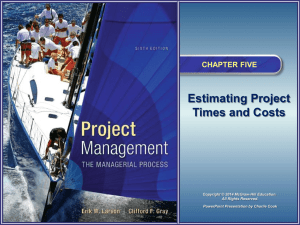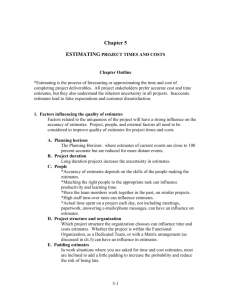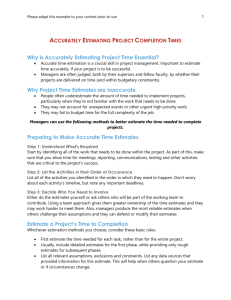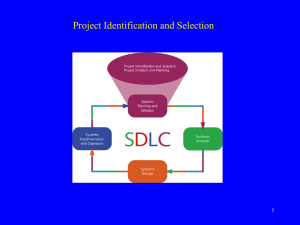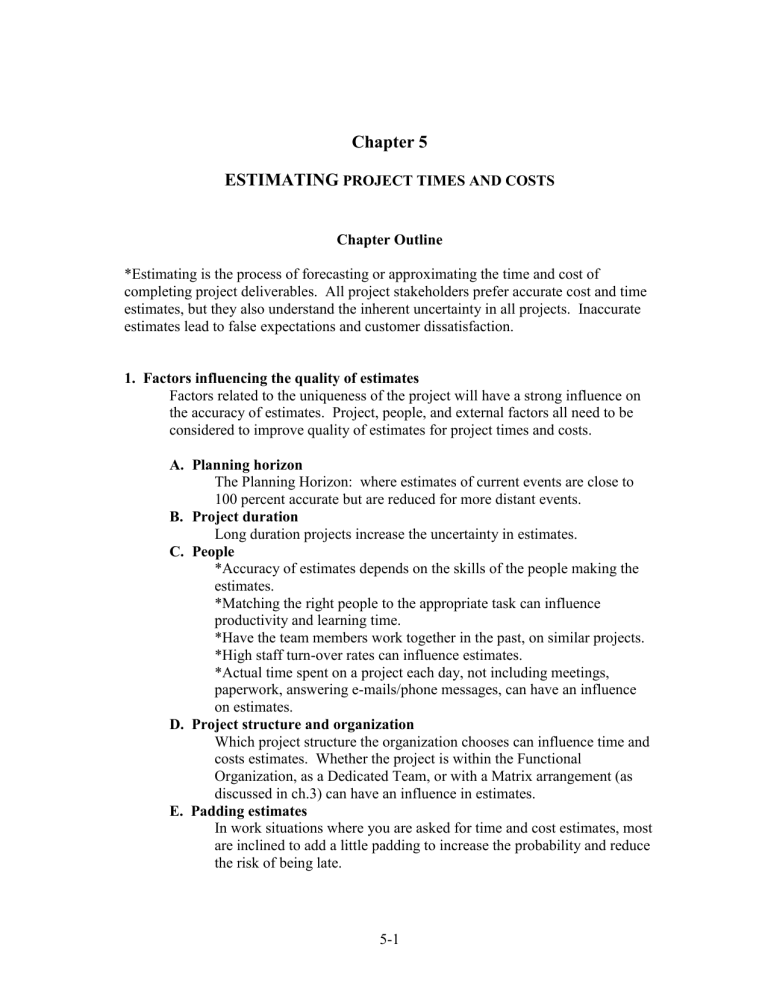
Chapter 5 ESTIMATING PROJECT TIMES AND COSTS Chapter Outline *Estimating is the process of forecasting or approximating the time and cost of completing project deliverables. All project stakeholders prefer accurate cost and time estimates, but they also understand the inherent uncertainty in all projects. Inaccurate estimates lead to false expectations and customer dissatisfaction. 1. Factors influencing the quality of estimates Factors related to the uniqueness of the project will have a strong influence on the accuracy of estimates. Project, people, and external factors all need to be considered to improve quality of estimates for project times and costs. A. Planning horizon The Planning Horizon: where estimates of current events are close to 100 percent accurate but are reduced for more distant events. B. Project duration Long duration projects increase the uncertainty in estimates. C. People *Accuracy of estimates depends on the skills of the people making the estimates. *Matching the right people to the appropriate task can influence productivity and learning time. *Have the team members work together in the past, on similar projects. *High staff turn-over rates can influence estimates. *Actual time spent on a project each day, not including meetings, paperwork, answering e-mails/phone messages, can have an influence on estimates. D. Project structure and organization Which project structure the organization chooses can influence time and costs estimates. Whether the project is within the Functional Organization, as a Dedicated Team, or with a Matrix arrangement (as discussed in ch.3) can have an influence in estimates. E. Padding estimates In work situations where you are asked for time and cost estimates, most are inclined to add a little padding to increase the probability and reduce the risk of being late. 5-1 F. Organization culture In some Organization Cultures padding is tolerated and sometimes encouraged, where in others it is not. G. Other factors Equipment down time, holidays, vacations, etc. 2. Estimating guidelines for times, costs, and resources There is substantial evidence suggesting that poor estimates are a major contributor to projects that have failed. Below are seven guidelines that can help a project manager with estimating. A. Responsibility Estimates should be made by those responsible for the task. Draw on their expertise! They will give an estimate based on experience and best judgment. A secondary benefit of using those responsible is the hope they will “buy in” to seeing that the estimate materializes when they implement the work package Finally, drawing on the expertise of team members who will be responsible helps to build communication channels early B. Use several people to estimate Cost and time estimates usually have a better chance of being realistic when several people with relevant experience/knowledge of the task are used. Different people bring different biases based on their experience. C. Normal conditions Estimates should be based on normal conditions, efficient methods, and a normal level of resources. If the normal workday is eight hours, the time estimate should be based on an eight-hour day. D. Time units Estimates of time must consider whether normal time is represented by calendar days, workdays, workweeks, weekends, shifts, hours, minutes, etc. Specific time units to use should be selected early in the development phase of the project network. All task time estimates need consistent time units. E. Independence Estimators should treat each task as independent of other tasks that might be integrated by the WBS. Be careful about aggregating many tasks into one time estimate, it could be too much of a “guestimate”. F. Contingencies Work package estimates should not include allowances for contingencies. The estimate should assume normal or average conditions, and add an extra fund for contingencies that can be used for unforeseen events. 5-2 G. Adding risk assessment to avoid surprises Simply identifying the degree of risk lets stakeholders consider alternative methods. Using new technology can be a risk. 3. Top-down versus bottom-up estimating Top-down: these estimates are sometimes made by top managers who have very little knowledge of the processes used to complete the project. . The fact that the estimate came from the top can influence people responsible to “do what it takes to make the estimate.” Bottom-up: o these estimates come from the people most knowledgeable about the estimate needed. o This process can take place after the project has been defined in detail. o The use of several people with relevant experience with the task can improve the time and cost estimate. The bottom-up approach also provides the customer with an opportunity to compare the low-cost, efficient method approach with any imposed restrictions. For example, if the project completion duration is imposed at two years and your bottom-up analysis tells you the project will take two and one-half years, the client can now consider the trade-off of the low-cost method versus compressing the project to two years—or in rare cases canceling the project. These steps should be done before final negotiation with either an internal or external customer. In conclusion, the ideal approach is for the project manager to allow enough time for both the top-down and bottom-up estimates to be worked out so that a complete plan based on reliable estimates can be offered to the customer. In this way false expectations are minimized for all stakeholders and negotiation is reduced. 4. Methods for estimating project times and costs A. Top-down approaches for estimating project times and costs At the strategic level top-down estimating methods are used to evaluate the project proposal. Sometimes much of the information needed to derive accurate estimates are not available at the proposal phase. For example, design is not finalized. In these situations, top-down estimates are used until the tasks in the WBS are clearly defined. 5-3 1. Consensus methods This method uses the pooled experience of senior and/or middle managers to estimate the total project duration and cost. This typically involves a meeting where experts discuss, argue, and ultimately reach a decision as to their best guess estimate. 2. Ratio methods (parametric method) Top-down methods usually use ratios to estimate project times and costs. Ex. Contractor may use cost per square foot for a project. If the project is 2.700 s.f. and it typically cost $160.00 per square feet, then a good ratio determination will be that the project will cost $432,000. Two other common examples of top-down cost estimates are the cost for a new plant estimated by capacity size and a software product estimated by features and complexity. 3. Apportion method This method is an extension to the ratio method. Apportionment is used when projects closely follow past projects in features and cost. Given hood historical data, estimates can be made quickly with little effort and reasonable accuracy. Anyone who has borrowed money from a bank to build a house has been exposed to this process. Function Point Methods for Software and System Projects In the software industry, software development projects are frequently estimated using weighted macro variables called function points or major parameters such as number of inputs, number of outputs, number of inquiries, number of data files, and number of interfaces. These weighted variables are adjusted for a complexity factor and added. The total adjusted count provides the basis for estimating the labor effort and cost for a project (usually using a regression formula derived from data of past projects). 4. Learning curves Some projects require that the same task, group of tasks, or product be repeated several times…the time to perform a task improves with repetition. Each time the output quantity doubles, the unit labor hours are reduced at a constant rate. In practice the improvement ratio may vary from 60 percent, representing very large improvement, to 100 percent, representing no improvement at all. The main disadvantage of top-down approaches to estimating is simply that the time and cost for a specific task are not considered. 5-4 B. Bottom-up approaches for estimating project times and costs 1. Template method If the project is similar to past projects, the costs from past projects can be used as a starting point for the new project. Differences in the new project can be noted and past times & costs can be adjusted to reflect the differences. 2. Parametric procedures As used in the Top-down approach, this technique can be applied to the Bottom-up approach as well. 3. Detailed estimates for the WBS work packages The most reliable method for estimating time and cost is to use the WBS and to ask the people responsible for the work packages to make the estimates. They know from experience or know where to find the information to estimate work package durations. Micro, bottom-up estimating methods are usually more accurate than macro methods. C. A hybrid: Phase estimating This approach begins with the Top-down estimate for the project and then refines estimates of phases of the project as it is implemented. It is used when an unusual amount of uncertainty surrounds a project and it is impractical to estimate times and costs for the entire project. Phase estimating uses a two-estimate system over the life of a project. A detailed estimate is developed for the immediate phase and a macro estimate is made for the remaining phases of the project. Unfortunately, your client will want an accurate estimate the moment decision is made to implement the project. The customer who is paying for the project perceives phase estimating as a blank check because cost and schedules are not firm over the life cycle of the project. 5. Level of detail Level of detail is different for different levels of management. The level of detail in the WBS gives management the ability to aggregate network information so each level of management has the information necessary to make decisions. However, excessive detail can also become a barrier to the project’s success, because the emphasis might lead to looking at department outcomes and not deliverable outcomes. 6. Types of costs A. Direct costs: these are real cost outflows that must be paid as the project progresses, such as Labor, Materials, Equipment, etc. B. Direct overhead costs: these are costs directly tied to the project deliverables or work packages, such as the Project Manager’s salary and temporary rental space for the team. 5-5 C. General and administrative overhead costs: these are costs not directly linked to a specific project, such as advertising and accounting. 7. Refining estimates A. Interaction costs are hidden in estimates. Here, there is an understanding that work on one task is dependent on prior tasks, therefore, the interactions between tasks will more than likely to take place during the life cycle of a project. B. Normal conditions do not apply. Estimates are supposed to be based on normal conditions. However, as an example, resource shortages, whether in the form of people, equipment, or materials, can easily extend original estimates. C. Things go wrong on projects. Here, the likelihood and impact of unforeseen events should be considered, such as Design flaws revealed after the fact, extreme weather conditions occur, accidents happening, etc. D. Changes in project scope and plans. Here, there is an understanding that changes in project scope and plans are very likely to happen in any project. Ex. Learning what the competitor is doing can cause a change in the scope or the client completely changing the entire design of a kitchen can have an impact. 8. Creating a data base for estimating The best way to improve estimates is collect and archive data. 9. Summary 5-6 1- After you determine the reason for a dependency between activities, you must determine the type of dependency. True 2- The project team should review an activity list and activity attributes with project stakeholders. True CH 6: FORWARD PASS: the biggest amount Backward PASS: the smallest number 5-7 NOTE: MEMORISED THE INSTRUCTION Developing the Project Network: The project network is the tool used for planning, scheduling, and monitoring project progress. The network depicts the project activities that must be completed, the logical sequences, the interdependencies of the activities to be completed, and in most cases the times for the activities to start and finish along with the longest path(s) through the network—the critical path. network is the framework for the project information system that will be used by the project managers to make decisions concerning project time, cost, and performance. some terms used in building project networks: 5-8


